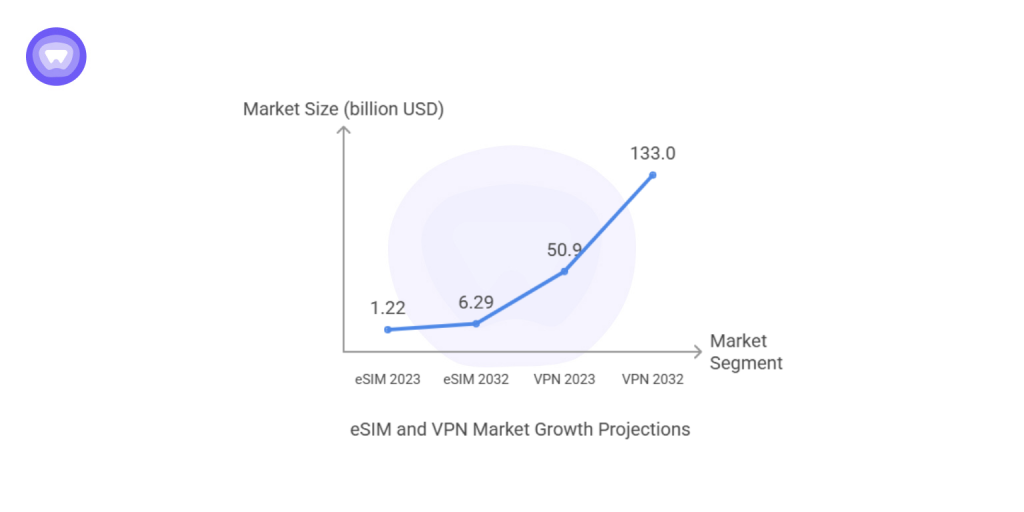If you’re running an eSIM business, you already know the margins are thinning.
The market is saturated. Customer acquisition is expensive. And nearly every player is competing on the same three levers: price, GBs, and coverage.
Here’s the question your leadership team should be asking:
Where’s the next layer of monetization coming from — without increasing CAC or adding product complexity?
eSIM VPN integration is the answer.
Not because it sounds good in a roadmap, but because it directly increases ARPU, reduces churn, and unlocks high-value geographies that most providers can’t touch.
Why Now? The Market Signals Are Clear
eSIM Growth:
- Global market size: $1.22B in 2023, projected to hit $6.29B by 2032
- By 2030, 76% of smartphones will be eSIM-native
VPN Adoption:
- 1.6 billion+ global users
- Penetration in Asia-Pacific: 25%+
- Usage in China doubled in 2024 despite regulatory blocks
- 42% of U.S. internet users now use a VPN weekly
The overlap is clear:

Mobile users in censored or surveillance-heavy regions demand secure access.
That’s what VPN-integrated eSIM solves — and monetized.
What Happens When You Integrate VPN Into Your eSIM Offering?

Let’s look at three key outcomes:
1. Revenue Growth
Even modest adoption drives material margin:
- 10,000 MAUs
- 25% conversion to VPN bundle
- $4/month uplift
➡ $3.15 profit × 2,500 users = $7,875/month
➡ Over $94,000/year in incremental MRR
No CAC change. No infra capex. Just smart monetization.
2. User Stickiness and Retention
Users with integrated VPN stay longer — because they’re relying on your product for privacy and accessibility, not just gigabytes.
| Metric | eSIM Only | eSIM + VPN |
| 90-Day Retention Rate | 61% | 83% |
| Trial-to-Paid Conversion | 21% | 35% |
| Churn (Monthly) | 11% | 5% |
This is no longer just about upsell. It’s about defensibility.
3. Market Access You Can’t Get Without It
If your users can’t access WhatsApp, Google, Slack, or Instagram the moment they land in China, UAE, or Turkey — they’re not going to blame the firewall. They’re going to blame you.
VPN-integrated eSIM unlocks these markets without product failure or refund requests.
Providers without VPN will avoid these regions. You won’t have to. With PureVPN White Label program, instantly get your own VPN made with zero technical hassles.
How to Integrate VPN Into eSIMs — A Step-by-Step Breakdown
For business leaders, integrating VPN into your eSIM stack must meet three core criteria:
- It must be invisible to the user
- It must not require app downloads in restricted markets
- It must not disrupt your provisioning or billing architecture
Here’s how successful eSIM providers are handling VPN integration today:
1. Decide Your Integration Model
There are two dominant paths:
A. App-Embedded VPN
This model uses a single mobile app that handles eSIM provisioning, plan selection, and VPN activation. It’s ideal for regions with open app stores.
- VPN is toggled on/off inside your app
- Good for UX-unified experiences
- Requires the app to be accessible via App Store or Play Store
B. Pre-Provisioned VPN Profiles
Best for high-censorship regions like China or UAE, this model connects users through VPN automatically when their eSIM connects to a network.
- No manual configuration needed
- Ideal when app stores are restricted
- VPN auto-connects silently in the background
Most serious providers deploy both to optimize across use cases.
2. Integrate Licensing Logic
You’ll need to map VPN entitlements to eSIM user plans. This can be done via:
- Voucher codes or license keys
- API provisioning between eSIM backend and VPN system
- Account-based access tied to user email or device ID
This ensures the right users get access at the right time — with billing handled on your side.
3. Brand the Experience
White-label VPN providers (like PureWL) let you:
- Use your brand on the apps
- Customize DNS, UI, and support messaging
- Set your own pricing tiers and free trial durations
- Control server availability by region or plan
This keeps the experience aligned with your brand while offloading all technical infrastructure.
4. Ensure Stealth + Regulatory Coverage
For VPN to work in restricted environments, it must support:
- Obfuscation protocols (e.g., OpenVPN XOR, Shadowsocks, Stealth VPN)
- Local failover and anti-DPI techniques
- Server distribution compliant with GDPR, Indian DoT, and other frameworks
If you’re serving users in China, the UAE, or Iran — your VPN infrastructure must be purpose-built for evasion.
5. Launch, Monitor, Monetize

Once integrated:
- Use real-time dashboards to monitor usage, server loads, and user engagement
- A/B test conversion across plans with and without VPN
- Offer trials (e.g., Free eSIM VPN integration for 7 days) to drive bundle upgrades
- Segment by geography to optimize regional plan pricing
Integration success isn’t just technical. It’s operational.
This Isn’t a Feature. It’s a Commercial Lever.
Without VPN:
- Your product breaks in key regions
- Support tickets rise
- Refunds spike
- User confidence drops
With VPN:
- You monetize the privacy expectation
- You enter blocked markets
- You protect and extend LTV
- You stop racing competitors to the bottom
Final Word
You don’t need to build a VPN.
You need to offer secure access to the markets and users who now expect it — and who will pay more for it.
Done right, VPN integration lifts revenue, defends your brand, and deepens user reliance without adding operational complexity.
Want to Launch This Without Tech Hassle?
PureWL gives you:
- Fully branded apps (iOS, Android, Windows, macOS)
- 6,500+ global VPN servers
- Built-in stealth protocols (China, UAE, Turkey)
- GDPR-compliant, zero-log infrastructure
- API + admin dashboard for license control
- No internal development required
Talk to PureWL to launch eSIM VPN integration in months. Monetize privacy without building it yourself.
Data is the product. VPN is the moat. Now you can sell both.


